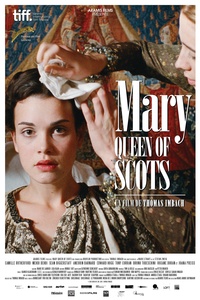Mary Queen of Scots
| Movie | |
|---|---|
| German title | Mary Queen of Scots |
| Original title | Mary Queen of Scots |
| Country of production | Switzerland |
| original language | English , French |
| Publishing year | 2013 |
| length | 120 minutes |
| Age rating | FSK 12 |
| Rod | |
| Director | Thomas Imbach |
| script | Thomas Imbach |
| production | Thomas Imbach, Andrea Štaka |
| music | Sofia Gubaidulina |
| camera | Rainer Klausmann |
| cut | Tom La Belle |
| occupation | |
| |
Mary Queen of Scots is a feature film by Swiss director Thomas Imbach from 2013 and his first film in English and French. The bilingual Camille Rutherford plays the leading role. Mary Queen of Scots tells the life story of the Scottish Queen Maria Stuart based on the biography written by Stefan Zweig . The film premiered at the Locarno International Film Festival in August 2013 and premiered internationally at the Toronto International Film Festival in September 2013 . The film was released in German-speaking Switzerland on November 7, 2013 and in French-speaking cinemas on January 15, 2014. In France, the film opened in cinemas on November 12, 2014, and in Germany on November 20, 2014.
action
At the age of 5, Mary Queen of Scots was brought to France from Scotland. The Scottish and English queens are said to be the bride of the French dauphin. Maria grows up in France and marries Franz II, but her reign is short-lived, as Franz dies a year later at the age of only 16. Mary's cousin Elisabeth is now sitting on the English throne. Maria decides to return to Scotland and at first has a hard time settling in there because she is used to the luxury of the French court. In the precarious situation between Catholics and Protestants, she manages to show tolerance and seeks closeness to the people. In order to be perceived as ruler, Maria hastily marries Lord Darnley, who soon turns out to be a mistake. The pregnant Maria loses the last bit of trust when Darnley, out of jealousy, has her faithful advisor Rizzio murdered. Maria carries her child and brings it to safety from Darnley.
When the Earl of Bothwell, a loyal ally, is wounded, Maria realizes her feelings for him. Her first physical encounter with Bothwell causes her to throw all common sense overboard and do anything for Bothwell. They make a plan to get rid of Darnleys. When the house in which Darnley resides goes up in flames and Mary marries Bothwell a short time later, a broad front of lords and commoners forms who demand a just punishment of the apparent murderer, the Earl of Bothwell. Maria is not ready to sacrifice Bothwell and so an army is recruited for defense. On the morning of the confrontation, however, it becomes clear that a fight is hopeless. Maria is forced to surrender and send Bothwell away.
In desperation, she turns to her cousin Elisabeth and flees to England. There, however, she is held to be complicit in Darnley's death and a threat to Elizabeth's throne and imprisoned. After 20 years of being locked up, Elisabeth grants her “redemption” through the ax.
Reviews
"It is not, or only in rudimentary form, the historical events, battles and quarrels that Thomas Imbach brings to the screen, rather it is Mary's inner world, it is her feelings, her own, often unadapted view of things too."
“The staging is of economic beauty, almost sparse. The colors of the Renaissance are, so to speak, embedded in the gray of a late Middle Ages. The language ceremony of unromantic courtly brutality. A young woman has been thrown into this world ... [...] Her passions as a girl must burn within. In Thomas Imbach's work, you set the Scottish stone landscape in a kind of feverish movement, and then he is completely the cinematic poet we know. [...] Camille Rutherford, Imbach's leading actress, plays it with a wonderful, cool intensity ... "
"With this film, the Swiss director has succeeded in doing nothing less than revitalizing the historical film through the greatest possible reduction."
“Thomas Imbach's 'Mary Queen of Scots' works with the maximum contrast between the incredibly complex history and the economical, disciplined staging. The complexity of the film may be overwhelming - but the first viewing experience impresses with its well-trained leanness. Imbach contrasts opulent ideas and connections with tableaux and scenes of impressive clarity and simplicity. "
Web links
- Mary Queen of Scots in the Internet Movie Database (English)
- Official website
- Mary Queen of Scots at Rotten Tomatoes
Individual evidence
- ^ Certificate of Release for Mary Queen of Scots . Voluntary self-regulation of the film industry , August 2014 (PDF; test number: 146 689 V).
- ↑ Filmbulletin: magazine for film and cinema. March 17, 2019, accessed March 17, 2019 .
- ↑ Christoph Schneider, The Queen's Many Small Deaths. In: Tagesanzeiger, August 14, 2013
- ↑ Christoph Heim, A woman who wants to realize herself. In: Basler Zeitung, p. 19ff. November 6, 2013
- ↑ Michael Sennhauser, Thomas Imbach's cat war of the queens. In: Swiss Radio and Television SRF.
